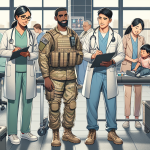Definition
Pain management, in the context of VA benefits, refers to a multidisciplinary approach employed by the Department of Veterans Affairs to address chronic or acute pain experienced by veterans. This approach involves medical treatments, therapy, and support aimed at reducing pain, enhancing function, and improving the veterans’ quality of life. Pain management services may include medication, physical therapy, counseling, alternative therapies, and other methods tailored to individual needs.
Key Takeaways
- Pain Management in the context of VA benefits refers to the medical services and treatments offered by the Department of Veterans Affairs to help veterans manage and alleviate their chronic or acute pain.
- These services may include a combination of therapies and medications, such as physical therapy, counseling, alternative treatments like acupuncture, pain medications, and other forms of specialized care designed to address the specific pain-related needs of the veteran.
- Veterans eligible for VA benefits can access these pain management services through the VA health care system, often at reduced costs or with financial assistance, which can help improve their overall quality of life and daily functioning.
Importance
The VA benefits term “Pain Management” is important because it acknowledges and addresses the physical and emotional discomfort experienced by veterans as a result of injuries, illnesses, or chronic conditions sustained during their military service.
As a crucial component of veterans’ healthcare, pain management involves the use of various medical treatments, therapies, and support services aimed at minimizing pain and improving overall quality of life.
These interventions not only help veterans maintain their day-to-day functionality but also enable them to participate in various rehabilitation and recovery programs more effectively.
Therefore, emphasizing the importance of pain management in VA benefits ensures that veterans receive the appropriate care and resources needed to lead healthier, more comfortable lives post-military service.
Explanation
The purpose of pain management as a part of VA benefits is to improve the quality of life of veterans who are experiencing pain caused by various conditions, including those related to their military service. Pain management focuses on minimizing both the physical and emotional aspects of pain, which can have detrimental effects on an individual’s well-being and daily functioning.
By offering a variety of treatments and therapies, the pain management program helps veterans regain control over their lives, participate in meaningful activities, and maintain a higher level of overall satisfaction. These approach ensures that veterans receive comprehensive care, reducing the burden of pain on their physical and mental health.
Pain management under VA benefits encompasses a range of interdisciplinary services, tailored to suit the unique needs of each veteran. The program caters to individuals struggling with acute or chronic pain, adopting a combination of pharmacological and non-pharmacological treatments such as meditation, physical therapy, pain-relief medications, acupuncture, and counseling.
By working closely with a team of healthcare professionals, including pain specialists, psychologists, and other allied health providers, veterans can develop an individualized pain management plan that effectively addresses their needs. Ultimately, the pain management services within VA benefits aim to provide comprehensive support to veterans on their journey to a better, healthier, and pain-free life.
Examples of Pain Management
Physical Therapy: A veteran experiencing chronic pain due to injury or illness might seek assistance from the VA Benefits system for physical therapy. Physical therapy can help improve function and mobility while reducing pain levels for patients with a variety of conditions, such as back pain, arthritis, or post-surgical recovery.
Medication Management: A patient with severe or persistent pain might require prescription medications to manage their pain effectively. The VA Benefits system offers assistance with medication management, covering prescriptions for pain relief options like nonsteroidal anti-inflammatory drugs (NSAIDs), opioids, or other treatments tailored to the individual’s specific needs.
Alternative and Complementary Therapies: VA Benefits also support veterans in accessing alternative and complementary therapies for pain management. This might include services such as acupuncture, chiropractic care, therapeutic massage, and hydrotherapy. These therapies can offer effective pain relief solutions for veterans who cannot or do not wish to utilize traditional pharmacological treatments.
FAQ – Pain Management
What is pain management in VA benefits?
Pain management in VA benefits refers to a range of medical services provided by the Department of Veterans Affairs to help veterans manage and alleviate acute or chronic pain associated with service-related injuries or conditions. These services include medical treatment, physical therapy, counseling, alternative therapies, and support programs.
Am I eligible for pain management services within the VA benefits system?
Eligibility for pain management services is determined on a case-by-case basis. Generally, veterans who are enrolled in the VA health care system and have pain related to a service-connected disability or chronic condition are eligible for these services. You can consult your primary care provider or a VA facility to determine your eligibility.
What types of treatments and therapies are available for pain management within VA benefits?
The VA offers a wide range of treatments and therapies for pain management. These include medication management, physical therapy, occupational therapy, cognitive-behavioral therapy, stress reduction techniques, and alternative therapies such as acupuncture, chiropractic care, and massage therapy. Your care team will work with you to develop a personalized pain management plan tailored to your needs and preferences.
How do I access pain management services within the VA benefits system?
To access pain management services, you should first consult with your primary care provider at a VA facility. They can assess your pain management needs and refer you to the appropriate specialists and treatments. You can also reach out to a Patient Advocate at your local VA facility for assistance in navigating the process.
Will I have to pay for pain management services within VA benefits?
Most pain management services are covered by VA benefits and are provided at no cost to the veteran. However, some services may require a copay, depending on your specific benefits coverage and eligibility. It’s always a good idea to consult with your VA care provider or a benefits specialist to understand any potential costs associated with your pain management plan.
Related VA Benefit Terms
- Chronic Pain Rehabilitation
- Physical Therapy
- Opioid Alternatives
- Acupuncture
- Cognitive Behavioral Therapy
Sources for More Information
- U.S. Department of Veterans Affairs – Pain Management
- My HealtheVet – Pain Management
- National Center for PTSD
- VAStrategy for Pain Management
 Benefits.com Advisors
Benefits.com Advisors
With expertise spanning local, state, and federal benefit programs, our team is dedicated to guiding individuals towards the perfect program tailored to their unique circumstances.
Rise to the top with Peak Benefits!
Join our Peak Benefits Newsletter for the latest news, resources, and offers on all things government benefits.





























